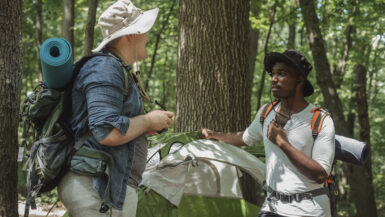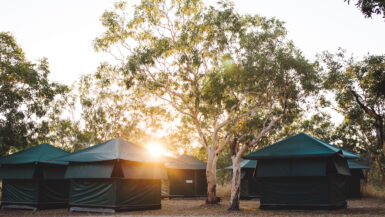Camping is a great way to connect with nature and take a break from the hustle and bustle of daily life. However, traditional camping practices can have a negative impact on the environment. From disposable plates and utensils to non-biodegradable waste, camping can leave a significant carbon footprint. Fortunately, there are ways to plan a green camping trip that is both enjoyable and eco-friendly. By following a few simple tips, you can reduce your impact on the environment and leave the campsite better than you found it. In this article, we’ll explore some of the best ways to plan a green camping trip and enjoy the great outdoors without harming the environment.
Choosing a Sustainable Campsite
When planning a green camping trip, the first step is to choose a sustainable campsite. Look for campsites that have eco-friendly practices in place, such as recycling programs, composting, and using renewable energy sources. National and state parks often have sustainable practices in place, and some even have certification programs for sustainable camping.
Consider the location of the campsite as well. Choose a site that is easily accessible by public transportation or bike, to reduce the carbon footprint of your trip. Avoid camping in sensitive areas or areas with endangered species, and make sure to follow all camping regulations and guidelines to minimize your impact on the environment.
Another option is to choose a campsite that supports local conservation efforts. Some campsites have partnerships with local organizations, and a portion of the camping fees goes towards supporting conservation efforts in the area. This is a great way to not only reduce your impact on the environment but also support local conservation efforts.
Overall, choosing a sustainable campsite is an important step in planning a green camping trip. Look for campsites with eco-friendly practices in place, consider the location and accessibility, and support local conservation efforts when possible.
Packing Eco-Friendly Camping Gear
When planning a green camping trip, it’s important to consider the impact of the gear you bring along. Many camping products, such as tents, sleeping bags, and cooking equipment, are made from synthetic materials that are not biodegradable and can have a negative impact on the environment.
To reduce your impact, consider investing in eco-friendly camping gear. Look for products made from sustainable materials, such as organic cotton, bamboo, or recycled materials. Many companies now offer eco-friendly camping gear options, so it’s easier than ever to find sustainable products that meet your needs.
Another way to reduce your impact is to choose gear that is multifunctional. For example, a sleeping bag that can also be used as a blanket, or a pot that can also serve as a bowl. This not only reduces the amount of gear you need to bring but also reduces waste.
When packing, make sure to bring reusable items, such as water bottles, utensils, and plates. Avoid single-use items, such as plastic water bottles or disposable utensils, as these can create a lot of waste.
Overall, packing eco-friendly camping gear is an important step in planning a green camping trip. Look for products made from sustainable materials, choose multifunctional gear, and bring reusable items to reduce waste.
Minimizing Waste and Reducing Your Carbon Footprint
When planning a green camping trip, it’s important to minimize waste and reduce your carbon footprint. There are many simple steps you can take to achieve this, such as:
Bring Reusable Items
One of the easiest ways to reduce waste is to bring reusable items, such as water bottles, utensils, and plates. Avoid single-use items, such as plastic water bottles or disposable utensils, as these can create a lot of waste.
Properly Dispose of Waste
Make sure to properly dispose of all waste, including food scraps and packaging. Look for recycling and composting programs at your campsite, and properly dispose of any trash in designated areas.
Reduce Energy Use
Reduce your energy use by using solar-powered lights or lanterns instead of traditional battery-powered options. If you need to charge electronic devices, consider investing in a portable solar-powered charger.
Walk, Bike, or Use Public Transportation
Reduce your carbon footprint by walking, biking, or using public transportation to get around the campsite or nearby attractions. This not only reduces your impact on the environment but also allows you to connect with nature and enjoy the surroundings.
Overall, minimizing waste and reducing your carbon footprint is an essential part of planning a green camping trip. Bring reusable items, properly dispose of waste, reduce energy use, and choose sustainable transportation options to minimize your impact on the environment.
Cooking and Eating Sustainably in the Outdoors
When planning a green camping trip, it’s important to consider how you will cook and eat sustainably in the outdoors. Here are some tips to help you reduce waste and minimize your impact on the environment:
Choose Local and Organic Food
When shopping for food, choose local and organic options whenever possible. This not only supports local farmers but also reduces the carbon footprint of your food by reducing transportation emissions.
Bring Reusable Containers and Utensils
Bring reusable containers and utensils to store and eat your food. This reduces waste from single-use packaging and utensils.
Use a Camp Stove or Fire Pit
Use a camp stove or fire pit instead of a disposable grill or charcoal. This reduces waste and minimizes the impact of your cooking on the environment.
Properly Dispose of Food Scraps
Properly dispose of food scraps by composting or using designated trash bins. This reduces the amount of waste you create and can also be used to fertilize plants in the area.
Clean Up Properly
Make sure to clean up after cooking and eating by properly disposing of waste and washing dishes. Leave no trace of your cooking and eating activities to minimize your impact on the environment.
Overall, cooking and eating sustainably in the outdoors is an important part of planning a green camping trip. Choose local and organic food, bring reusable containers and utensils, use a camp stove or fire pit, properly dispose of food scraps, and clean up properly to minimize your impact on the environment.
Leave No Trace Principles and Responsible Camping Practices
When camping in the outdoors, it’s important to follow Leave No Trace principles and practice responsible camping. This means minimizing your impact on the environment and leaving the campsite in the same or better condition than you found it. Here are some tips to help you practice responsible camping:
Pack In, Pack Out
Pack out all your trash, including food scraps and packaging. Do not leave any trash or waste behind.
Stay on Designated Trails
Stay on designated trails to minimize your impact on the environment. Avoid damaging plants or disturbing wildlife.
Respect Wildlife
Respect wildlife by keeping a safe distance and not feeding them. Do not disturb their habitat or interfere with their natural behavior.
Use Established Campsites
Use established campsites instead of creating new ones. This minimizes the impact on the environment by reducing soil erosion and damage to vegetation.
Minimize Campfire Impact
If you have a campfire, use established fire rings and make sure to properly extinguish the fire before leaving. Do not create new fire rings.
Overall, practicing Leave No Trace principles and responsible camping practices is an important part of planning a green camping trip. Pack out all your trash, stay on designated trails, respect wildlife, use established campsites, and minimize campfire impact to minimize your impact on the environment.
Connecting with Nature and Supporting Local Conservation Efforts
Camping provides a great opportunity to connect with nature and support local conservation efforts. Here are some tips to help you make the most of your camping trip:
Learn About the Local Environment
Take the time to learn about the local environment and the plants and animals that call it home. This not only helps you appreciate the beauty of the area but also allows you to understand the importance of conservation efforts in the area.
Participate in Conservation Efforts
Participate in local conservation efforts by volunteering with organizations or participating in clean-up events. This is a great way to support the local community and make a positive impact on the environment.
Choose Eco-Friendly Activities
Choose eco-friendly activities to enjoy while camping, such as hiking, bird watching, or kayaking. These activities allow you to connect with nature and appreciate the beauty of the area without leaving a negative impact on the environment.
Support Local Businesses
Support local businesses by shopping at local markets or purchasing products made by local artisans. This supports the local economy and helps to preserve the natural beauty of the area.
Overall, connecting with nature and supporting local conservation efforts is an important part of planning a green camping trip. Learn about the local environment, participate in conservation efforts, choose eco-friendly activities, and support local businesses to make a positive impact on the environment and the local community.
Eco-Friendly Activities to Enjoy While Camping
Camping provides a great opportunity to enjoy nature and participate in eco-friendly activities. Here are some ideas for eco-friendly activities to enjoy while camping:
Hiking and Nature Walks
Explore the natural surroundings by going for a hike or nature walk. This is a great way to appreciate the beauty of the area and get some exercise while minimizing your impact on the environment.
Bird Watching
Bird watching is a fun and relaxing activity that allows you to appreciate the beauty of local bird species. Bring along a bird identification guide and binoculars to enhance the experience.
Stargazing
Enjoy the night sky by stargazing. This is a great way to connect with nature and appreciate the beauty of the universe without leaving a negative impact on the environment.
Swimming and Water Activities
Cool off by going for a swim or participating in water activities, such as kayaking or canoeing. Make sure to follow all safety guidelines and avoid disturbing wildlife or damaging the environment.
Photography
Capture the beauty of the area by taking photographs. This is a great way to appreciate the natural surroundings and share the experience with others.
Overall, there are many eco-friendly activities to enjoy while camping. Hiking and nature walks, bird watching, stargazing, swimming and water activities, and photography are all great options for connecting with nature and minimizing your impact on the environment.
Planning a Zero-Waste Camping Trip
Camping is a wonderful way to connect with nature, but unfortunately, it can also generate a lot of waste. From disposable plates and cutlery to single-use packaging, it’s easy to accumulate a lot of trash while camping. However, with a little bit of planning, it’s possible to enjoy a zero-waste camping trip.
Choose Reusable Gear
One of the easiest ways to reduce waste while camping is to choose reusable gear. Instead of disposable plates, cups, and cutlery, opt for durable, washable options that you can use again and again. You can also bring a reusable water bottle and coffee mug to cut down on waste from disposable cups and bottles.
Plan Your Meals Carefully
Food waste is a major issue, both at home and while camping. To minimize waste while camping, plan your meals carefully. Try to bring only what you need and opt for non-perishable foods that won’t spoil quickly. If you do bring perishable items, make sure to store them properly in a cooler with plenty of ice.
Compost and Recycle
Even if you’re careful about what you bring, there will still likely be some waste generated while camping. To minimize the impact, make sure to compost and recycle as much as possible. Check with the campsite to see if they have composting or recycling facilities, and if not, bring your own bags and containers to take your waste with you.
Leave No Trace
Finally, it’s important to follow Leave No Trace principles when camping. This means packing out all of your trash and leaving the campsite in the same condition you found it. By being mindful of your impact on the environment, you can help ensure that future generations can enjoy the beauty of nature as well.
A zero-waste camping trip may seem daunting, but with a little bit of planning and preparation, it’s definitely achievable. By choosing reusable gear, planning your meals carefully, composting and recycling, and following Leave No Trace principles, you can minimize your impact on the environment and enjoy a sustainable camping trip.
Sustainable Transportation Options for Camping
Getting to your campsite is an important part of any camping trip, but it’s also an opportunity to make a sustainable choice. Here are some eco-friendly transportation options to consider for your next camping trip.
Biking
If your campsite is within biking distance, consider riding your bike instead of driving. Not only is biking a great way to reduce your carbon footprint, but it’s also a fun way to enjoy the outdoors and get some exercise. Make sure to bring a sturdy bike lock and a helmet for safety.
Public Transportation
If your campsite is located near a bus or train station, consider taking public transportation instead of driving. This is a great option for those who want to reduce their carbon footprint and avoid the hassle of driving and parking.
Carpooling
If you’re traveling with friends or family, consider carpooling to your campsite. This is a great way to reduce the number of cars on the road and cut down on emissions. Plus, it’s a fun way to bond with your fellow campers on the way to your destination.
Electric or Hybrid Vehicles
If you have access to an electric or hybrid vehicle, this is a great option for a sustainable camping trip. These vehicles have much lower emissions than traditional gas-powered cars, so you can enjoy your trip while minimizing your impact on the environment.
Walking
If your campsite is located nearby, consider walking instead of driving. This is a great way to enjoy the outdoors and get some exercise while reducing your carbon footprint. Just make sure to pack light and bring comfortable walking shoes.
By choosing a sustainable mode of transportation for your camping trip, you can reduce your impact on the environment and enjoy a more eco-friendly vacation. Whether you choose to bike, take public transportation, carpool, or walk, there are plenty of options to consider. Just make sure to plan ahead and choose the option that works best for you and your group.





Leave a reply